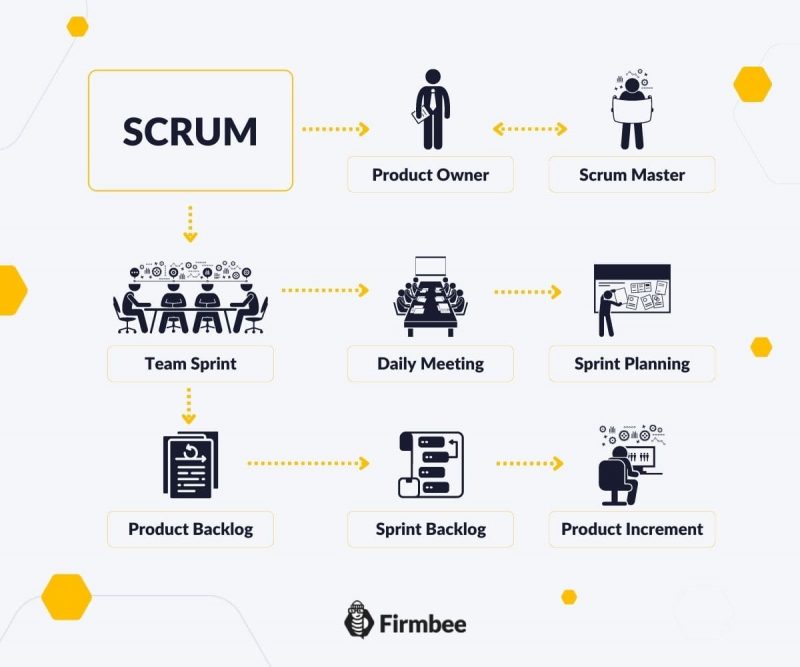Although the framework of Scrum is simple, its implementation in a company is not an easy task. Scrum is used to optimize teamwork, but initially, it can cause a lot of trouble. And even aggravate existing problems in the organization. So how to implement Scrum in your company?
How to implement Scrum – table of contents:
- How to implement Scrum in your company?
- Implementation. The task for Scrum Master
- Interdisciplinarity. How do you build a Development Team?
- Scrum Rhythm. Separating the Scrum Team
- Is it worth implementing Scrum?
- Summary
How to implement Scrum in your company?
Many entrepreneurs come up with the idea of using Scrum principles in their company. Scrum promises great team effectiveness, an energetic atmosphere, and no hierarchy. However, it sets very specific requirements for both the team and the individual people in Scrum Team.
When deciding to implement Scrum, it is worth considering the technical and organizational details. So let’s look at potential implementation issues, required team member competencies, and ways to separate Scrum Team from the overall organization.
Implementation. The task for Scrum Master
During Scrum implementation, the key figure is the experienced Scrum Master. The Scrum Master is solely responsible for the proper understanding of Scrum by all involved. Also, he or she assesses and amends all operations according to Scrum principles and values.
Hiring Scrum Master with experience is critical if the company’s employees have not worked with Scrum principles before. They will probably have a lot of questions, and Scrum Events will require detailed guidance by Scrum Master for at least the first few weeks.
The Scrum Master’s tasks are limited to the role of coach and leader, once the members of the future Development Team know the Scrum principles well enough. So, before starting other activities, answer the question: Are you able to find and hire the right Scrum Master?
Interdisciplinarity. How do you build a Development Team?
The next question a Scrum implementer must answer is:
Is my company already staffed with people capable of creating a self-sufficient, interdisciplinary team?
We will provide a detailed description of how the Development Team works in Scrum in the next article in Scrum Guide series. Here we will only mention two problems that may arise during the creation of the Team:
- lack of sufficiently mature (senior) staff with complementary competences,
- rigid organization structure.
All members of Scrum Team should be specialists in their field. And their competencies should be complementary to each other. A well-composed, interdisciplinary team should not be dependent on the help of external specialists.
This is especially substantial if the Team is working with confidential and sensitive data that should not be shared with people outside the organization. Using external help also disrupts one of the pillars of Scrum, transparency. It can also create the risk of creating hierarchies within the Team. For example, separating ”second-class developers”, people who will not take full part in Scrum Team activities.
Problems with Scrum implementation may arise when the company is divided into strictly separated departments. If each member of Development Team works in a different department – a great deal of reorganization will be necessary. One of the topics to think about is a common workspace for an interdisciplinary team.

Scrum Rhythm. Separating the Scrum Team
Another key issue to consider while implementing Scrum is to create a kind of ”firewall” to protect the fresh Scrum Team from the influx of external tasks. It will probably be formed by people who worked on other projects in your company.
By force of habit, people with whom the new Scrum Team members have worked will continue to seek their help. And this can generate conflicts, cause an influx of additional tasks, and disrupt the rhythm of Scrum Events.
Is it worth implementing Scrum?
If you are seriously considering implementing Scrum in your company and are aware of the problems that may arise, analyze again whether Scrum is definitely the solution for you.
“Yes” has been said to Scrum by as many as 66% of agile teams. However, the statistics don’t show how effective the teams are freshly after implementation. Nor how long it takes to get to and then surpass pre-Scrum efficiencies.
What’s more, paying a lot of attention to the size of the Scrum Team and the volume of projects the team will undertake. We will describe the problems associated with scaling Scrum in a separate article.

How to implement Scrum – summary
If you expect great team effectiveness, an energetic atmosphere and a lack of hierarchies in the team, you should certainly consider using Scrum. A good practice is to entrust its implementation to an experienced Scrum Master. You should also check if your company has specialists with complementary competencies. Additionally, make sure that Scrum Team works in a sufficiently isolated environment so that the rhythm of its activity is not disturbed by the flow of tasks from other departments.
If you like our content, join our busy bees community on Facebook, Linkedin and Twitter.
Author: Caroline Becker
As a Project Manager, Caroline is an expert in finding new methods to design the best workflows and optimize processes. Her organizational skills and ability to work under time pressure make her the best person to turn complicated projects into reality.
Scrum Guide:
- Glossary of basic terms, roles and notions
- What is Scrum?
- Scrum values
- How to implement Scrum in your company?
- Scrum Team - what is it and how does it work?
- Who is a Product Owner?
- The most common mistakes of Product Owner
- Who is the Scrum Master?
- Characteristics of a good Scrum Master
- The most common mistakes of Scrum Master
- What statistics and metrics should the Scrum Master track?
- Cooperation between Product Owner and Scrum Master
- Development Team in Scrum
- The most common mistakes of Developers
- Scrum artifacts
- Scaling Scrum
- Sprint Backlog
- What is the Product Backlog?
- What are User Stories?
- Creating the best User Story with INVEST
- The most common User Story mistakes
- User Story Acceptance Criteria
- Estimation and Story Points in Scrum
- Planning Poker
- Team Estimation Game
- Defining Increment
- Scrum events
- What is Sprint in Scrum?
- Scrum Team Commitments - Product Goal, Sprint Goal and Definition of Completion
- What is a Burndown Chart?
- How to create and interpret a burndown chart?
- Advantages and disadvantages of the burndown chart
- Kanban boards in Scrum and Scrumban
- Velocity in Scrum - Speed of the Development Team
- Daily Scrum
- Sprint Planning
- Sprint Review
- What is a Sprint Retrospective?
- Common mistakes during a Sprint Retrospective
- Product Backlog nurturing


















